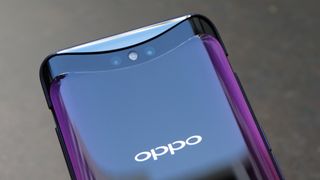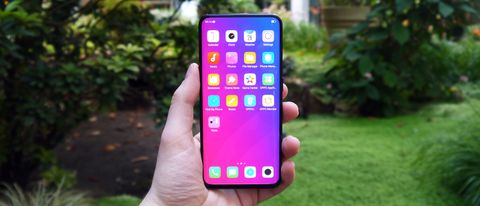Why you can trust TechRadar
Camera
- Dual-lens primary camera
- 25MP front-facing camera
- Extensive beautification
Tap on the camera app and up pops that sliding drawer again, housing its dual rear camera (16MP + 20MP) as well as its 25MP selfie camera. While we won’t dwell much further on this feature, we will mention that it makes holding the phone in landscape a little awkward due to the spongy resistance it gives in the hand.
Oppo’s camera app offers just about every photo and video mode we’ve come to expect from an Android flagship in 2018, with portrait, panorama, sticker, and expert modes for capturing stills, and slo-mo and time-lapse joining the standard video affair.
With that said, it’s slightly strange that there isn’t any settings menu to speak of. You can’t lay a grid over the display in order to align shots better, for instance, and neat modes such as light-painting and long exposure that appear in Huawei flagships aren’t present here.
Several of these settings are available on both the front and rear camera, meaning you can apply the bokeh-style portrait effects to selfies or film yourself in slo-mo. And then, of course, there’s the beauty settings…

If you’ve used an Android from a Chinese or Korean manufacturer in recent years then you’re likely familiar with 'beauty' modes, but the Find X might just sport the most extreme example of this tech we’ve yet seen.
Beyond some fairly standard auto-beauty settings, and some much deeper individual tweaks like 'dermabrasion', 'slim face', and 'whiten teeth', the Find X can also employ 3D facial scanning capabilities.
This technology allows you to create a kind of 3D-modelled death mask (or, as Oppo calls it, a 'Custom 3D Beautified Look') that apparently uses AI to apply 'delicacy', 'loli' or 'model' tweaks to the structure of your face in photos. Unfortunately, it doesn’t play nicely with beards.

Gimmicks aside, the front-facing camera is really quite powerful and, with the availability of several modes, is one of the better options for the selfie-inclined on the market.
As for the primary dual-lens snapper, the images are definitely up to scratch with many other Android handsets, but they suffer a little more when in low-light conditions than most other 2018 flagships.
However, Oppo’s AI is surprisingly good at detecting the subject of your shots, adjusting the image settings accordingly whether you’re capturing blue sky, text, indoors, or landscape.





Performance
- Snapdragon 845 with 8GB RAM
- Adreno 630 is solid for gaming
- No NFC
As we mentioned earlier, Oppo’s crammed in some real beef when it comes to internal components, and it pays off quite smartly across the board.
The Qualcomm Snapdragon 845 is still the chipset to beat for Android handsets, and alongside 8GB of RAM, this is a top-shelf combo. In our history of benchmarking using PCMark Work, the Find X has the top score with 9,971, with the nearest competition (the HTC U12+) more than 1,000 points lower.
Its Geekbench 4 single- and multi-core scores also impress (2,316/7,764), with little in the way of competition outside of Samsung’s latest line of Galaxy flagships.
This makes for a handset that is beyond capable when it comes to everyday tasks – we never noticed a single stutter in practice – and will excel at more compute-heavy tasks as well.
As for its graphical prowess, the Adreno 630 GPU is either the best in the mobile realm, or very close to it. Once again, the Oppo Find X topped our charts for all of our 3DMark and GFXBench tests, narrowly beating the HTC U12+, despite sharing the same GPU.
As we mentioned earlier in the battery tests, we did find that GPU-intensive tasks seemed to drain the battery at a much faster rate comparable to other handsets, so it’s likely that there’s an optimization issue in this area.

Now, we’ve raved about the hardware potency of the Find X, but this isn’t the only ingredient in the performance recipe. A common area of concern for Oppo is its user interface, and unfortunately the OS is no less frustrating with this flagship.
Aiming for an Apple-esque style iOS feel, ColorOS often manages to combine the worst of the two competing platforms. While there may be iOS-style simplicity, the hidden functions are somewhat vital to Android handsets, and when it comes to the customizations and ‘clever’ adjustments you can make, the OS is often too pushy in its approach.
While ColorOS certainly isn’t the slickest Android skin around, many of its quirks can be overcome (or at least adjusted to) with use. While that's a compromise some people may be willing to make, some of its annoyances are frankly difficult to forgive.
For instance, the inability to swipe away notifications with a single gesture (it requires a swipe and a tap) is much more frustrating than we were expecting it to be. Considering the average user will be doing this dozens of times a day, it’s no small inconvenience to be doubling the effort required.
Current page: Camera and performance
Prev Page Design, display and battery Next Page Verdict and competition
John joined TechRadar over a decade ago as Staff Writer for Phones, and over the years has built up a vast knowledge of the tech industry. He's interviewed CEOs from some of the world's biggest tech firms, visited their HQs and has appeared on live TV and radio, including Sky News, BBC News, BBC World News, Al Jazeera, LBC and BBC Radio 4. Originally specializing in phones, tablets and wearables, John is now TechRadar's resident automotive expert, reviewing the latest and greatest EVs and PHEVs on the market. John also looks after the day-to-day running of the site.
